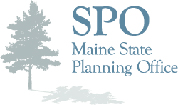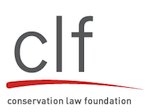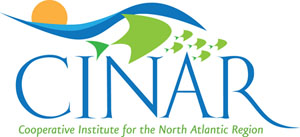“Imagine that you are the manager of a corporation. Now imagine that you know fewer than half the people who work for you and you have no idea what the other half does. In this situation, you can’t manage very well.”
With this analogy, Lewis Incze, a biological oceanographer at the University of Maine and Principal Investigator for the Gulf of Maine Area (GoMA) program of the Census of Marine Life, described the situation facing those who would safeguard the world’s oceans and the motivation behind an audacious, 10-year long project to describe the inhabitants of marine environments around the globe.
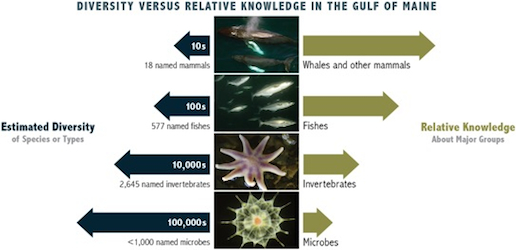
Figure 1: While the inventory of species in the Gulf of Maine area is far from complete, many key aspects of biodiversity are becoming better understood. Large conspicuous species, especially those of commercial importance, are best understood. Also, those organisms that live near the coast are better known than those in deep water offshore. Yet, research shows that lesser known species – including microscopic organisms – play critical roles in ecosystem functioning. (Photos, top to bottom: Peter Stevick, Jon Witman, Christine Kulfan, Linda Amaral Zettler)
The Census of Marine Life (CoML), initiated by the Alfred P. Sloan Foundation in 2000, was designed to add to our knowledge of biodiversity in the world’s oceans. As the program drew to a close in 2010, most would agree that it had exceeded all expectations in its “decade of discovery.”
Most of the projects within CoML focused on the deep ocean where sampling has been particularly deficient. The relatively shallow (<200 m, <321.8 km) seas along the edges of continents (the so-called “shelf seas”) make up only 8 percent of the global ocean, but they are also home to a huge diversity of sea life. This is the area of the ocean most heavily used and impacted by humans. The Gulf of Maine area was chosen as CoML’s regional “coastal margin” ecosystem pilot project. Peter Lawton, Co-principal Investigator of the Gulf of Maine Area (GoMA) Program and a research scientist with Canada’s Department of Fisheries and Oceans (DFO) in New Brunswick, explained some of the reasons for this selection. Heavily used, best studied
“First, it is one of the best studied marine systems in the world. Second, it has a history of heavy use (mostly fishing, but other uses as well), and there is a wide variety of government agencies, nongovernmental organizations and academic scientists working to improve management approaches. Third, despite extensive knowledge about the Gulf, it is recognized that only a fraction of the regional biodiversity is known, and even less is understood about how this biodiversity contributes to the functioning and adaptability of the ecosystem.
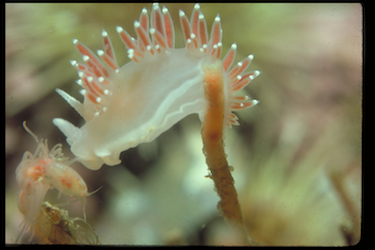
Figure 2.
“How can we implement ecosystem-based management (EBM) under such conditions? What do we presently know about biodiversity, and what are some of the needs and useful strategies going forward? Research conducted by CoML could catalyze discussions and investments in answering these questions,” said Lawton.
GoMA defined its study area as the Gulf of Maine proper (including the Bay of Fundy), Georges Bank and the Great South Channel, the western Scotian Shelf (south of a line extending from Halifax to the continental slope), the continual slope from the Halifax line to the Great South Channel, and Bear Seamount (on the deeper part of the slope south of Georges Bank). Extending the study beyond just the Gulf of Maine made it more comprehensive of regional oceanographic and biogeographic processes and built a stronger international effort between the U.S. and Canada.
Graham Shimmield, former chair of the European branch of CoML and now Executive Director of the Bigelow Laboratory for Ocean Sciences in West Boothbay Harbor, Maine, described the impetus for the massive global research program as the need to “establish a baseline against which future change can be measured.”
Noting that “70 percent of the global population lives within 50 miles of the coast,” Shimmield added “with more uses and more users, every part of the ocean is now affected by man…we have changed the whole ecology of the oceans by exploiting the resources that live there.”
“The global ocean represents an asset of diminishing value… if we don’t master our understanding of the oceans and incorporate this into the way we manage our affairs, we should expect that this value will continue to diminish,” Incze said. “Our understanding of the oceans lags behind that of the terrestrial realm because it is harder to see and study. Ocean research is expensive, painstaking, and time consuming.”
CoML was designed to give a boost to ocean researchers interested in biodiversity and “do for the oceans what terrestrial ecologists did for tropical rainforests a number of years ago,” Incze said.
Importance of biodiversity
Why is biodiversity important? A greater variety of genes (within-species diversity) and species helps to buffer ecosystems from the effects of environmental changes that are driven by natural processes and human activities. In a sense, biodiversity is a warehouse of response options. Biodiversity also delivers many important “ecosystem services” of value to people, from nutrient recycling to fish production and aesthetic enjoyment. Thus, conserving biodiversity at functional levels is one of the objectives of EBM.
Researchers say some basic questions that need answers about the Gulf of Maine area are: 1) Who lives here (that is – what is the regional biodiversity)? 2) How is this diversity distributed (what are the patterns)? 3) What processes affect biodiversity – both positively and negatively? And 4) how does biodiversity affect the system? In other words, why does biodiversity matter to this area and what do we need to do to conserve it? There is an immense amount to learn, and one of the practical challenges is to devise research and management strategies that deliver on these important needs.
The Gulf of Maine Area census worked with scientists and databases to assemble a list of more than 5,600 named species in the Gulf of Maine area, tripling the original estimate of what was known. And yet, it is estimated that thousands more species remain to be discovered and described (the estimate excludes bacteria, which are many times more diverse. (See Fig. 1)
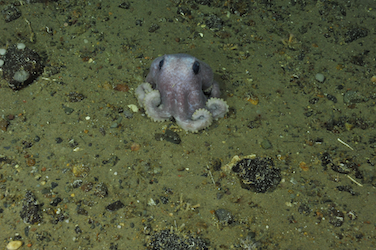
Figure 3.
As a result of the census, an updated register of the named species will soon be available to researchers and any other interested people (see http://www.gulfofmaine-census.org, and http://www.marinebiodiversity.ca). The register is being developed so that species names are linked to other sources of information about the species (e.g., authoritative descriptions, ecology, life history) and to databases on their distributions in the Gulf of Maine and elsewhere around the world (see Ocean Biogeographic Information System: http://www.iobis.org).
Rubber boots to ROVs
Lawton described the work of the GoMA program as stretching across a range of scales of size and complexity and utilizing technology varying from “rubber boots to remotely operated vehicles (ROVs).” Work in Cobscook Bay, Maine, for example, incorporated detailed identification of life in the intertidal zone, while new acoustic technologies conducted unprecedented studies of herring schools the size of Manhattan Island. Other studies went beyond enumerating species to assessing the ecological role played by species and their physical habitat. Such studies have to focus on fairly small areas.
Other projects looked at the full sweep of the Gulf. One combined data on 27 physical and oceanographic factors to assess environmental drivers of distribution patterns of organisms throughout the Gulf. A wide range of approaches to studying the Gulf is important because, as Incze and Lawton both emphasize, ecological structure is itself created by physical factors and biological processes operating at multiple scales.
Lawton noted that the concept of “ecosystem services” provides “a framework where scientists and managers can work together to decide what information is needed, bridging the challenging gap between the curiosity-driven basic research at the heart of CoML and the very applied nature of most marine management issues. Managers often must focus on a given species, working to ensure that harvests are sustainable or that a threatened species is protected. Ecologists generally take a more holistic view, seeing each species as part of the larger ecosystem.” Ultimately, EBM requires that these two approaches get integrated.
“Sustainable fish production is, after all, a by-product of a complex set of requirements and many interacting species, and the best way to ensure production into the future is to ensure that all the parts of the system (such as genes, species, and habitats) are able to function and respond naturally,” said Incze.
In the meantime, the many legacies of the Census of Marine Life and its Gulf of Maine Area program will continue to help drive scientific discovery and management applications, said the scientists. Data generated by the program are now incorporated in the Ocean Biogeographic Information System, an online database, available to all as a place to find, store, and share data. Many research papers prepared by CoML scientists are available to anyone with an internet connection through the Public Library of Science, an organization committed to providing open access to research results.
At a major conference held in London last October, scientists from around the world agreed that one of the greatest legacies of CoML is the teams of researchers that came together to tackle a wide range of research projects. CoML provided the opportunity to work across geographic, cultural, and institutional boundaries to invigorate research in marine biodiversity. The Gulf of Maine Area program was one of those showing how to lay the groundwork for productive collaborations – and effective input into management – well into the future.
The Census of Marine Life: A Decade of Discovery
2,700 scientists
80+ nations
540 expeditions
US$ 650 million by all nations
2,600+ scientific publications
6,000+ potential new species
Side bar:
Gulf of Maine Area Studied
Area: 46,700 square miles
New species discovered since 2000: 13 named; many collected that need further analysis
Named species : >5,600
Species yet to be discovered: thousands
Websites:
Census of Marine Life: http://www.coml.org/
Gulf of Maine Area program of the Census of Marine Life: http://www.gulfofmaine-census.org/
Centre for Marine Biodiversity: http://www.marinebiodiversity.ca/
Ocean Biogeographic Information System: http://www.iobis.org/
Public Library of Science: http://www.plosone.org/
Related Gulf of Maine Times articles:
What Lies Beneath: Exploring the Gulf of Maine Biodiversity Discovery Corridor (http://www.gulfofmaine.org/times/summer2007/biodiversity.html)
Surprising Species Diversity Revealed (http://www.gulfofmaine.org/times/spring2006/species2.html)





